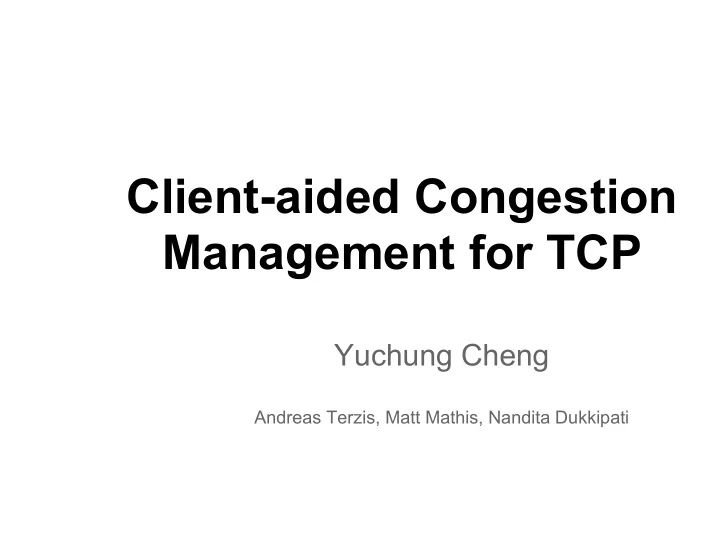

Client-aided Congestion Management for TCP Yuchung Cheng Andreas Terzis, Matt Mathis, Nandita Dukkipati
Motivation: TCP throttles app performance ● Apps today use lots connections ○ Even with intelligent ADF multiplexing, e.g., SPDY ○ Persistent connection is common practice ● Every new connection has to (re)discover the network ○ ~90% Google HTTP responses delivered in initial TCP slow start ○ on average a connection is used for 3 requests only
A smart (or not-so-dumb) transport should ... ● Share network states among connections ○ Past and current active ones ○ Save or amortize reprobing time, e.g., slowstart ● A congestion manager (CM) on top of connections, not inside connections ○ New connection starts fast (as if it's never been disconnected) ○ Should recover fast and avoid timeout at all cost ○ N connections are as good as 1 ■ Disincentivize parallel connections
Sender-side CM approach ● Theory and practice ○ RFC 2140 - TCP Ctrl Block Sharing by J. Touch '97 ○ Congestion Manager by H. Balakrishnan, SIGCOMM '98 ○ Ensemble-TCP by L. Eggert, CCR '00 ○ SCTP, '00 ○ Structured Stream Transport by B. Ford, SIGCOMM '07 ○ Multi-path TCP ● Pros ○ Easy: sender traditionally holds all CC states ○ Fast deployment: maybe one side change only ● Cons ○ Scale: connections to same dst must hit same (physical) host ■ Difficult with large server farm load-balancing ■ Need big cache for the ever-growing Internet ○ Fragile: many devices/paths behind one client IP due to NAT
Can the client help? ● The client is the hub of its connections ○ Naturally the place for caching and sharing ○ Scales well ○ NAT is not a problem ● The client often knows better about the bottleneck: last-hop ○ Link properties: wired, wifi, or cellular ○ Link rate: edge vs 3G ○ Link failure and recovery ○ Dormant or active ● E.g., why RTO backoff then slow-start when a client can hint the sender the broken cellular link has recovered
Great Snipe: a client-based congestion management ● A new TCP CC framework ○ Not a new congestion control Client algorithm Congestion Manager ● Move congestion control to the client Flow ○ Connections on the same path share Query/ Stats one cwnd Reply ■ also RTT, loss rate, reordering, F 1 F 2 F n etc ○ Network properties cached at the client Outgoing Incoming Data ACKs ○ Use options for signalling ● Server handles e2e reliability ○ Detect and recover losses
Client-based congestion control ● Client as data receiver Client Server ○ Client maintains size of congestion SYN window (cwnd) ○ Client passes cwnd to sender in ACKs SYN/ACK ○ Sender limits # of outstanding packets to cwnd ● Benefit ACK cwnd:4 ○ Allows cwnd caching and reuse ● Client as data source ○ Same as TCP today
Implementing standard AIMD ● Connections on the same path share one cwnd (acwnd) ● On startup ○ Slow start with IW10 if no prior history ○ cwnd = acwnd / N otherwise ● On losses ○ Server performs traditional loss recovery and informs client ○ acwnd = ssthresh ■ Reduce once across multiple losses or connections ○ acwnd = 1 ■ If nothing received from the same dst for last RTO ● After cwnd reduction ○ acwnd += 1 per RTT ● Upon completion ○ acwnd remains same
Research issues / opportunities ● A pure client-based maybe overkill ○ What if client just guides the server somehow ● Sender announces the backlog to allow better acwnd allocation? ● Track one way delay (OWD) ○ New delay-based congestion control? ● Co-exist with traditional TCP and other protocols ○ E.g., interactive or real-time protocols ● Detect shared bottlenecks among different paths ● Reusing / sharing other states, e.g., loss rates, reorderig, etc ● Energy efficiency
Conclusion ● Congestion control should be on top of individual logic connections ● Server-based congestion manager has practical scale issue ○ Client may offer interesting opportunities to improve CC today! ○ Often knows the network better ○ Naturally the sharing point ○ Scale well ● Great Snipe: move CC to client and on top of indiv. connections ○ Still in early development stage ○ Will release to the public for testing like Laminar ● Feedback & ideas welcome! ycheng@google.com
Recommend
More recommend